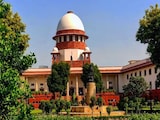- Containment zone is where many positive cases have been found
- In these zones routes leading into the area are blocked completely
- The limitations are imposed to prevent further spread of the virus
For residents of Delhi's three containment zones - Dilshad Garden (Northeast Delhi), Nizamuddin and South Moti Bagh (South Delhi) - life has become different from other people under the nationwide lockdown.
Most routes leading into their area are now blocked completely and even those going out for ordinary things have to answer the police a lot more and are closely tracked. They are now witnessing things like trucks being used to block the roads to drones being used to disinfect the area, on a daily basis.
According to the Health Ministry, a 'containment zone' refers to a defined geographical area where positive cases of coronavirus have been found and in order to prevent further spread of the virus, movement restrictions are put in place to physically keep the people in.
The perimeters of the containment zone are decided based on factors such as number of cases, contact tracing history and population density.
All measures such as deployment of health and security officials, surveillance rules, hospitalisation procedures are also planned based on these factors.
Almost a one kilometre radius in each of these areas now has restricted movement and access.
The Delhi State Cancer Institute, which has become a cause of worry after 18 coronavirus positive staff members - including two doctors and 16 nurses tested positive, is already in the containment zone of Dilshad Garden.
Hospital sources say that samples of at least 19 patients have currently been sent for testing. The source of infection is a doctor whose family members returned from UK recently. Over 45 staff of this 180-bed hospital have now been quarantined.
Dilshad Garden became a containment zone after a 38-year-old woman who returned from Saudi Arabia was detected positive and infected eight others including a mohalla clinic doctor.
Out of the 11 points that lead to Sector L of Dilshad Garden, which reported most cases, nine have been completely shut with police barricades and neither vehicles nor pedestrians are allowed, not even essential services ones.
Almost a one kilometre radius in each of the containment zone now has restricted movement and access.
Only two routes are open for movement. But only residents of the area are allowed to go in and that too after heavy enquiry. No outsiders are allowed. Even for residents, the checking sometimes goes to the extent that even if they are on foot and claim to be going out to buy vegetables with a bag in hand, the police photographs them to keep a record.
Shops of food and medicines within the area however are allowed to remain open like any usual area. Even though they have to take so many detours, residents and shopkeepers claim that they prefer the movement restrictions because it has prevented outsiders.
Tina Singh, a resident of Dilshad Garden, said, "Our residents are managing really well. The mischievous elements, the cops are handling."
Vijay Kumar, a grocery store owner in Dilshad Garden, said, "People are getting all the stuff right now. But the mini trucks that come to refill stock are coming less frequently though. Lots of outsiders used to take all these routes so best that restrictions have been put in place."
In Nizamuddin too, where over 300 cases from the Markaz tested positive in Delhi, similar movement restrictions are in place and massive sanitisation efforts like spraying of disinfectants through drones and fire engines is being done on a daily basis.
The latest containment zone is a slum in South Moti Bagh in South Delhi where a resident who used to work as a sanitation worker at AIIMS tested positive on Saturday. Out of fear that the densely populated slum could lead to more cases, authorities acted fast.
Now, out of five routes that lead to the slum, entry and exit of vehicles as well as pedestrians at four routes has been fully blocked either through barricades or by parking big trucks across the road.
Only one route is open for movement. Sanitisation workers come to disinfect the area at least thrice every day and provision of essential services is also being done in a manner that does not disturb social distancing.
Uday Singh, a ration shop owner, said, "Ever since a man was found coronavirus positive, the people and officials here have shifted the usual sabzi mandi 500 metres away. All the other shops close by have also been shut down. Government officials come both during the day and in the evening. Even now you can see the Gypsy parked there. But people can buy basics nearby - at 100 metres distance there is a Mother Dairy and one can get fruits and vegetables there."
Today, Delhi's Health Minister Satyendra Jain declared that in the upcoming days more random sampling will be done in areas which have higher number of cases.
"We have ordered one lakh rapid testing kits which produce results in 10-15 minutes. These kits will be first used in the two hotspot zones of Dilshad Garden and Nizamuddin. Currently, screening is on in Nizamuddin. As soon as the kits come we will begin testing also", said the minister.















